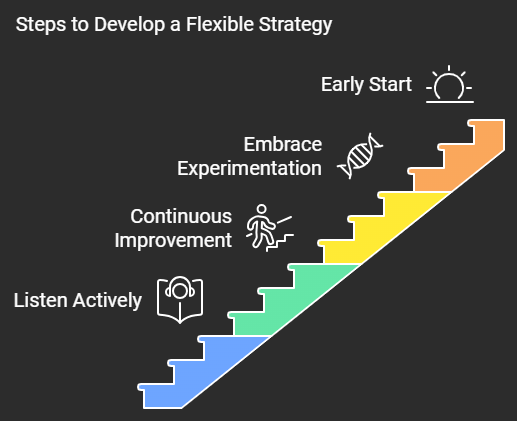Adaptive Strategy: Real-World Examples
Adapting to change is important in today’s ever-changing world. This skill is needed in business and education to adjust strategies and overcome new challenges. Real-life examples of adaptive strategies can inspire and provide insights for navigating change. Let’s explore practical examples in different contexts to learn from their real-world applications.
What Is An Adaptive Strategy?
Why Changing Your Plan is a Big Deal
Changing your plan is a big deal. It’s important to consider and weigh the implications of such a decision carefully. It can have a significant impact on your overall strategy and goals, necessitating the need for adaptability and flexibility. Failing to do so may lead to potential consequences, such as confusion within the organization, decreased morale, and hindered progress.
Frequently changing your plan can result in turbulence and instability, making it difficult to establish solid foundations for future success. Therefore, it’s crucial to implement an adaptive strategy. This strategy should encourage collaboration, continuous improvement, and experimentation. This will help you effectively navigate the uncertain waters of changing plans.
Starting Steps for Flexible Strategy

Listen More Than You Talk
When developing an adaptive strategy, listening more than talking is important. This allows you to gather diverse perspectives and insights, leading to better decisions and adjustments. Actively listening ensures that all voices are heard, promoting a comprehensive understanding of challenges and opportunities.
In a team setting, practical ways to listen more than talk include encouraging open dialogue, providing equal opportunity for everyone to share their thoughts, and actively engaging with the ideas and feedback of others. This promotes a collaborative environment where everyone feels valued and can contribute to refining the strategy.
Always Make Things Better
Improving things is important for staying competitive and relevant in today’s rapidly changing business environment. It helps companies continuously improve and innovate, avoiding stagnation and falling behind.
Flexibility and adaptability improve organizations’ ability to respond to changing market conditions, customer needs, and technological advancements.
Embracing experimentation and being open to failure allows companies to pivot and innovate, making improvements along the way.
Technology plays a role in continuously improving and adapting strategies by keeping up with ongoing trends and innovation. It allows for the documentation of strategies, tracks technologies used, and saves iterations for easy sharing and access, promoting the implementation of adaptive approaches to strategy.
Technology also enables companies to embrace a collaborative and inclusive approach and incorporate learnings to make regular iterations. This eliminates rigid timelines and allows companies to adjust strategies as needed.
Trying New Things
Trying new things can be beneficial for businesses. It encourages experimentation and innovation, helping companies stay flexible and adapt to market changes. For example, a retail company trying out new product lines can better respond to customer preferences and improve flexibility.
Embracing new approaches means being open to failure and learning from mistakes. This creates a culture of continuous improvement, where businesses make iterative changes and pivot as needed. For instance, they can establish a cycle of trials and make improvements based on successes and failures.
Technology supports this process by helping document strategies and track innovations. Digital tools like Lucidspark can make sharing information easier, tracking changes, and saving iterations easier. For example, a tech startup can use data analytics to monitor new features’ performance and quickly adjust based on real-time user feedback, enabling rapid adaptation.
Get an Early Start
Getting an early start is important for adapting to change. It allows for more time to gather insights, experiment, and adapt. Organizations can test and iterate strategies, making it easier to adjust courses as needed. Taking an early start also helps develop a flexible strategy by enabling companies to document technology and processes, track changes, and share information effectively.
Companies can adopt an adaptive strategy by embracing experimentation, being open to failure, and promoting inclusivity and collaboration. They can also begin by focusing on a subset of building blocks that can help establish core practices and tackle specific issues. By incorporating these steps, companies will be well-equipped to adapt to inevitable changes and stay ahead of the curve.
Using Tech to Stay Agile

Writing Down Tech Stuff Helps You Adapt
Writing down tech stuff helps individuals and organizations adapt to change. It provides a documented record of their technological processes and tools, making it easier to track changes, share information, and revisit past iterations.
Using technology offers real-time insights and enables crowd-sourcing and distributed decisions. It helps stay agile and flexible in strategy. Incorporating technology into adaptive strategies keeps up with ongoing trends and innovation. It also embraces experimentation and openness to failure for pivoting and innovating.
Furthermore, technology enables a flexible strategy creation, review, maintenance, and update process. It allows for the capture of ideas, insights, and relevant information. It creates an enduring, visionary, and flexible Essential Intent (EI) for defining team strategy.
Strategy is Like Sailing

Choosing the Right Direction
The starting steps for developing a flexible strategy involve:
- Eliminating top-down strategy
- Promoting collaboration and inclusivity
- Continuously improving the strategy
- Embracing experimentation
- Starting early to adjust strategy as needed
These steps allow for a more adaptive and agile approach to strategy development, ensuring that the company can pivot and innovate as necessary.
Technology can help in choosing the right direction by:
- Keeping up with ongoing trends and innovation
- Documenting strategies and tracking technologies used
- Saving iterations for easy sharing and access
Moreover, embracing technology allows for effective tracking of changes and information sharing.
When changing course every 90 days, it is important to avoid:
- Routes that are indecisive and lack the necessary clarity to make difficult decisions
- Prioritizing short-term gains over long-term vision
This is crucial to maintaining the right strategic course.
Routes to Avoid
When implementing an adaptive strategy, it’s essential to avoid common routes that could hinder its success. For instance, collaboration and inclusivity should be favored instead of a top-down approach, encouraging input from all team members. Also, starting early and adjusting strategy as needed without rigid timelines is better.
Identifying and avoiding these routes can contribute to a successful, flexible strategy. This approach promotes continuous improvement and embraces experimentation, failure, and innovation. It allows for incorporating learnings and regular iterations, ensuring the strategy remains agile and adaptable to ongoing trends and innovation.
By avoiding potential pitfalls, companies can establish a more effective and enduring strategy open to change and flexibility, ultimately contributing to long-term success in a dynamic and competitive business environment.
Changing Course Every 90 Days
Changing course every 90 days is essential. It helps organizations stay ahead of market trends, foster innovation, and remain responsive to changing consumer needs and technological advancements.
Constantly evaluating and adjusting the strategic direction allows the organization to remain agile and competitive.
Technology plays a role in staying agile. It provides real-time insights and crowdsourcing and continually scans strategy-related information. This allows for rapid feedback loops, quick decision-making, and the ability to identify shifts in consumer behavior or market dynamics.
The starting steps for developing a flexible strategy involve eliminating top-down strategies, embracing collaboration, and actively implementing processes like continual scanning and strategy sprints.
It is important to listen more than talk. This helps one understand market shifts and consumer needs, which is essential for successful adaptation and innovation.
What to Do in the Next 3 Months?
Making a List of What to Do
To make a list of what to do in the next 3 months, follow these steps:
- Embrace experimentation and be open to failure to allow room for pivoting and innovating as necessary.
- Commit to continuously improving strategy by incorporating learnings and making regular iterations.
- Start early and adjust strategy as needed to stay agile in adapting to changing plans.
- Create a flexible strategy by eliminating top-down strategy and promoting collaboration and inclusivity.
- Utilize technology to document strategies, track technologies used, and save iterations for easy sharing and access.
- This allows for effective communication and collaboration in implementing adaptive strategies.
Moving Fast and Together
Be Speedy Boats, Not Slow Cruise Ships
Organizations need to be agile and adaptable. This helps them navigate changes and stay ahead of the competition. Agility allows quick responses to market shifts, tech advancements, and changing customer needs. It also supports continuous improvement, experimentation, and flexible strategy.
Technology aids agility by documenting strategies, tracking tech, and enabling easy sharing. It also helps you stay updated with trends, gain real-time insights, and find new opportunities.
Organizations should focus on collaboration, continuous improvement, and early adjustment to implement a flexible strategy. Distributed decision-making, strategy sprints, and continual processes can help maintain and update strategies effectively.

Vizologi is a revolutionary AI-generated business strategy tool that offers its users access to advanced features to create and refine start-up ideas quickly.
It generates limitless business ideas, gains insights on markets and competitors, and automates business plan creation.
Vizologi
A generative AI business strategy tool to create business plans in 1 minute
FREE 7 days trial ‐ Get started in seconds
Try it free

